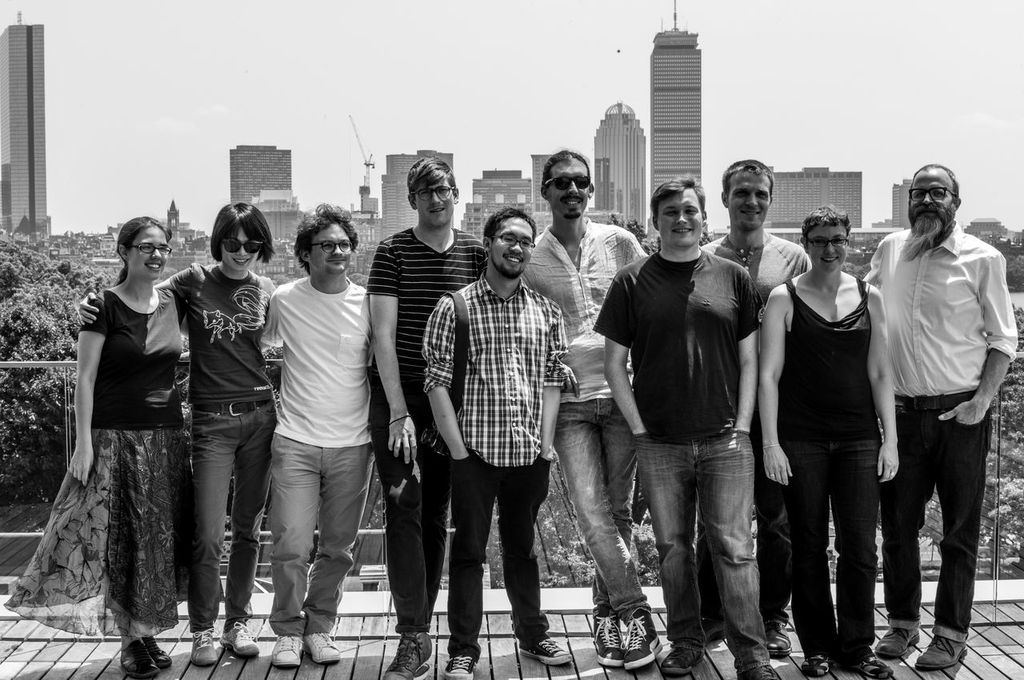
Knight-Mozilla fellows strive for global impact in journalism
The eight 2013 Knight-Mozilla Fellows aim to build a diverse ecosystem around open web development that connects traditional journalists and technologists. Photo credit: Knight-Mozilla Fellows Related Link
The 2013 Knight-Mozilla fellows are data-savvy experts embedded in eight of the world’s most influential newsrooms. Their mission: find solutions that will benefit an industry in desperate need of change. How to better measure their impact is a challenge they all share.
“In just a couple of years, OpenNews has become one of the core bridges between the world of open source web makers and the newsroom,” said John Bracken, director of journalism and media innovation at Knight Foundation, which has partnered with the nonprofit Mozilla on the effort.
Now in its third year, the fellowship program represents a $2.5 million investment by Knight in attracting coders and technologists to accelerate media innovation in newsrooms. Fellows with all 2013 partner organizations — the BBC, the New York Times, the Guardian, the Boston Globe, La Nacion, Spiegel Online, ProPublica, the BBC and Zeit Online — receive a $60,000 stipend. Their technical solutions serve as scalable models that can be adapted and replicated by news organizations across the world.
Throughout the 10-month program, camaraderie between the fellows–online and offline–runs deep. Their research is part of a shared online repository, which serves to standardize social data metrics. When they aren’t online, fellows organize newsroom presentations, attend conferences and help to organize hackathons. Simultaneously, each fellow continues to develop their own technical capacity to better understand and meet the needs of everyday citizens.
“I just adapt and adapt,” Sonya Song, a fellow at the Boston Globe said. “For the last 10 years, I’m not sure I know how to label myself. I study social sciences and adapt to whatever the industry needs.”
Song, a native of China, says her role as a fellow is to help increase data fluency at the Globe. She describes herself as an academic who studies media economics and censorship. One of the biggest challenges, Song says, is convincing traditional journalists that data analysts can be a real asset to storytelling.
“Some journalists don’t like recent changes in the industry and feel like certain privileges and access are being taken away from them,” Song said. “Many privileges are just gone, but what I am showing in my presentation is that those stories can be covered by other means with new tools. It’s just as investigative and exclusive as before.”
However, Brian Abelson, a 26-year-old fellow at the New York Times, describes himself as more of a data scientist than a journalist. Regardless, he says, the two terms are inseparable.
“Impact is why people get into journalism in the first place,” said Abelson, who collaborates regularly with Song on an Internet Relay Chat (IRC) forum. “What we need to be asking isn’t how many page views did I get, but how much impact did I make.”
One of the major limitations of the news industry today, Abelson said, is that measuring impact is sometimes done in a very informal way. It’s important for even the most seasoned journalists to explore new ways to measure data, he said. Abelson described the day he asked an editor what tools they used to measure impact:
“Out came a manila folder with a lot of anecdotal evidence — scraps of paper, Post-its, e-mails, and news clippings — that they would translate into an award application or report,” Abelson said.
The OpenNews project shows that all newsrooms can take steps to better utilize developers, he said.
“There is this fear that metrics will lead journalists to become ‘the Buzzfeeds of media’ when you steer what you’re doing editorially toward achieving better metrics,” Abelson said. “The challenge for us [fellows] is to make sure our approach is not to fundamentally change the way newsrooms work. We need to meet them in the middle.”
Stijn Debrouwere, 25, a freelancer, consultant, technologist and fellow at the Guardian, said he can’t quantify how much open-source software he has put out on the web as part of his Knight-Mozilla project. But that doesn’t really make a dent, he said, when it comes to the basics that are left to explore.
“[If] you want to approach impact, everybody’s interested in the same thing and there’s always room for collaboration,” Debrouwere said. “We simply don’t have the data we need and so whatever your angle, until we figure out those basics, we’re working on the same problem.”
Collaboration between the fellows reached critical mass following this year’s MIT- Knight Civic Media Conference in Cambridge, Mass.; fellows from 2012 and 2013 met one-on-one to discuss media impact trends.
“We generally just try to be sounding boards for each other,” Debrouwere said. “We’re on IRC all day and talk about tons of newsy and nerdy things. It’s great. I don’t think I’d survive this fellowship without the support of my fellow fellows.”
Daniel Sinker, director of Knight-Mozilla OpenNews, said it’s exciting to see collaboration between the fellows happen at this level. Shared experience benefits the fellows individually, he said, and helps to better guide the industry toward economic solutions.
“Among the fellows, there is this realization that they need to get a lot better at metrics and data as soon as possible,” Sinker said. “The more newsrooms know about readers and [how to better define what ‘impact’ means] is important to the health of the industry, and the fact that our fellows can share what they’re finding helps move everyone forward instead of just one organization.”
Applications for 2014 Knight-Mozilla Fellowships are open now. News partners for next year include: La Nacion, the New York Times, ProPublica, the Texas Tribune and a joint fellowship placement with Ushahidi and Internews-Kenya.
Jenna Buehler, executive assistant/communications at Knight Foundation
Recent Content
-
Journalismarticle ·
-
Journalismarticle ·
-
Journalismarticle ·


